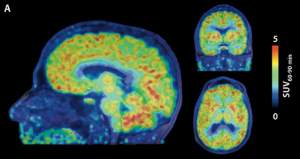
Martinostat imaging reveals
levels of HDACs
Courtesy of MGH
Researchers have little understanding about the interactions between genes and the environment and how they affect the human brain. A new PET radiotracer developed by Massachusetts General Hospital (MGH) called Martinostat may be able to offer insight.
This is the first time that epigenetic activity, the process that determines whether or not genes are expressed, is able to be assessed within the human brain. Researchers at the Martinos Center for Biomedical Imaging at MGH are investigating the expression levels of epigenetics-regulating enzymes in the brains of healthy patients.
They can now investigate the reasons why some people who are genetically predisposed to a disease are protected from it and why events during early life and adolescence have such a long-term impact on brain health.



Ad Statistics
Times Displayed: 2687
Times Visited: 20 Fast-moving cardiac structures have a big impact on imaging. Fujifilm’s SCENARIA View premium performance CT brings solutions to address motion in Coronary CTA while delivering unique dose saving and workflow increasing benefits.
Enzymes called histone deacetylases (HDAC) play an important role in regulating gene transcription and one group of HDACs is associated with certain brain disorders. A few established neuropsychiatric drugs are HDAC inhibitors and others are being evaluated as possible treatments for Alzheimer's disease and Huntington's disease.
“HDAC dysregulation has been implicated in a growing number of brain diseases, so being able to study HDAC regulation both in the normal brain and through the progression of disease should help us better understand disease processes,” Jacob Hooker of the Martinos Center, said in a statement.
The MGH researchers conducted PET scans with Martinostat of the brains of eight healthy patients. They found characteristic patterns of uptake, which reflects the HDAC expression levels, that were consistent among all of the patients.
HDAC expression was almost twice as high the the gray matter of the brain compared to the white matter. Within the gray matter, the uptake was highest in the hippocampus and amygdala and lowest in the putamen and cerebellum.
Hooker and his colleagues have initiated studies involving patients with several neurologic or psychiatric disorders. He believes that Martinostat will help them understand the different ways that these disorders manifest as well as provide insight into potential treatments.
A report that discusses Martinostat and the epigenetic research is published in the journal,
Science Translational Medicine.

